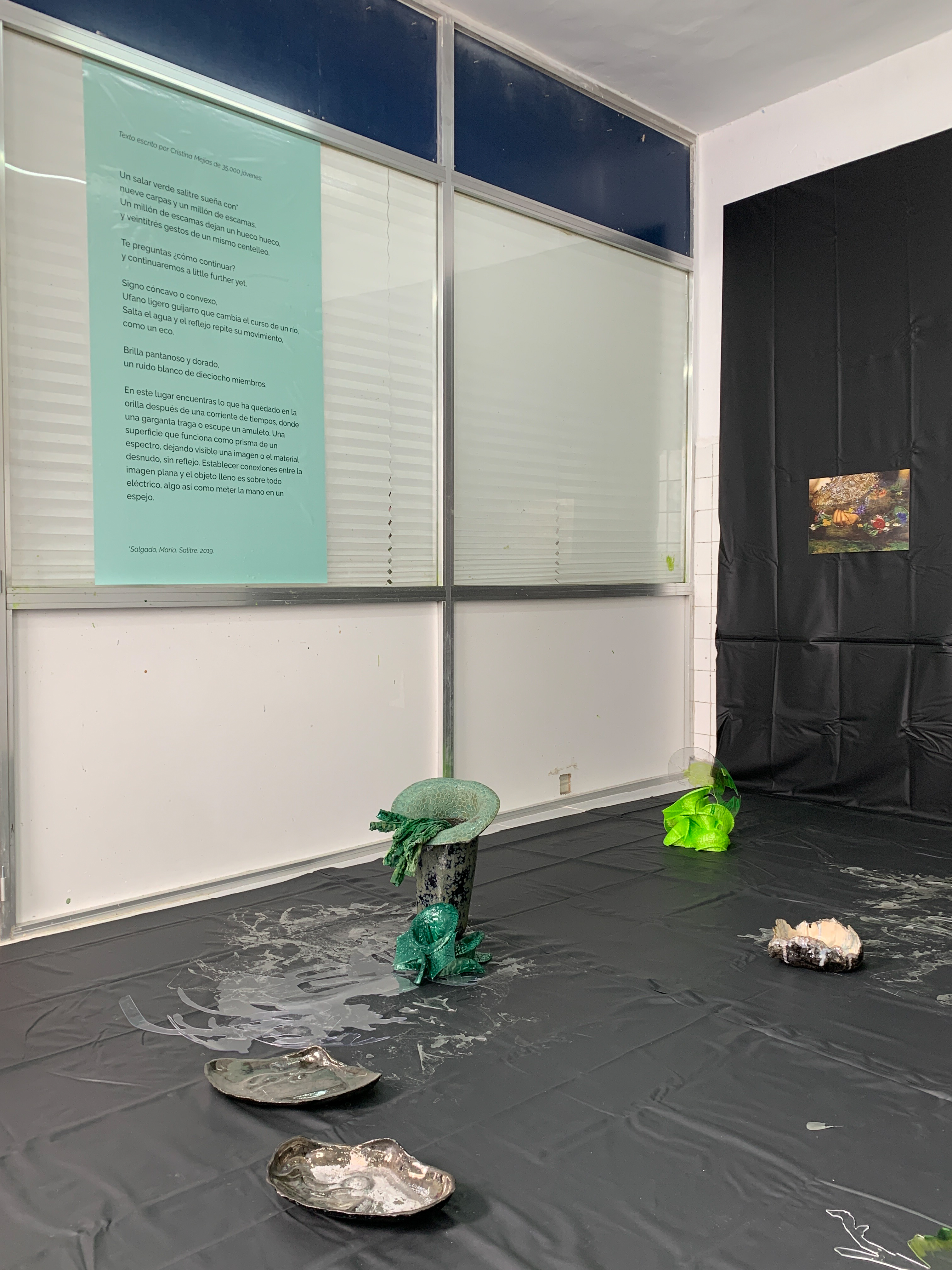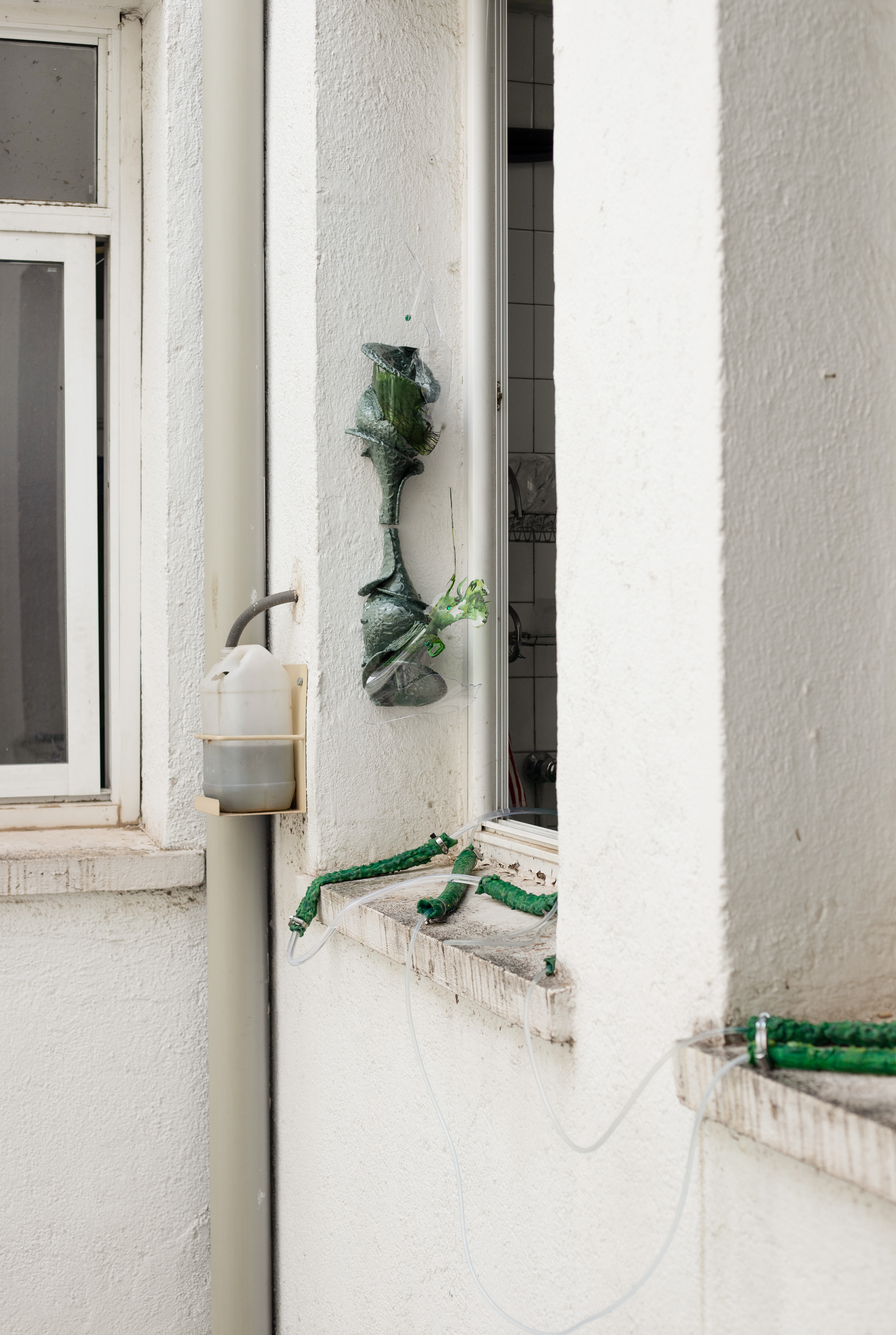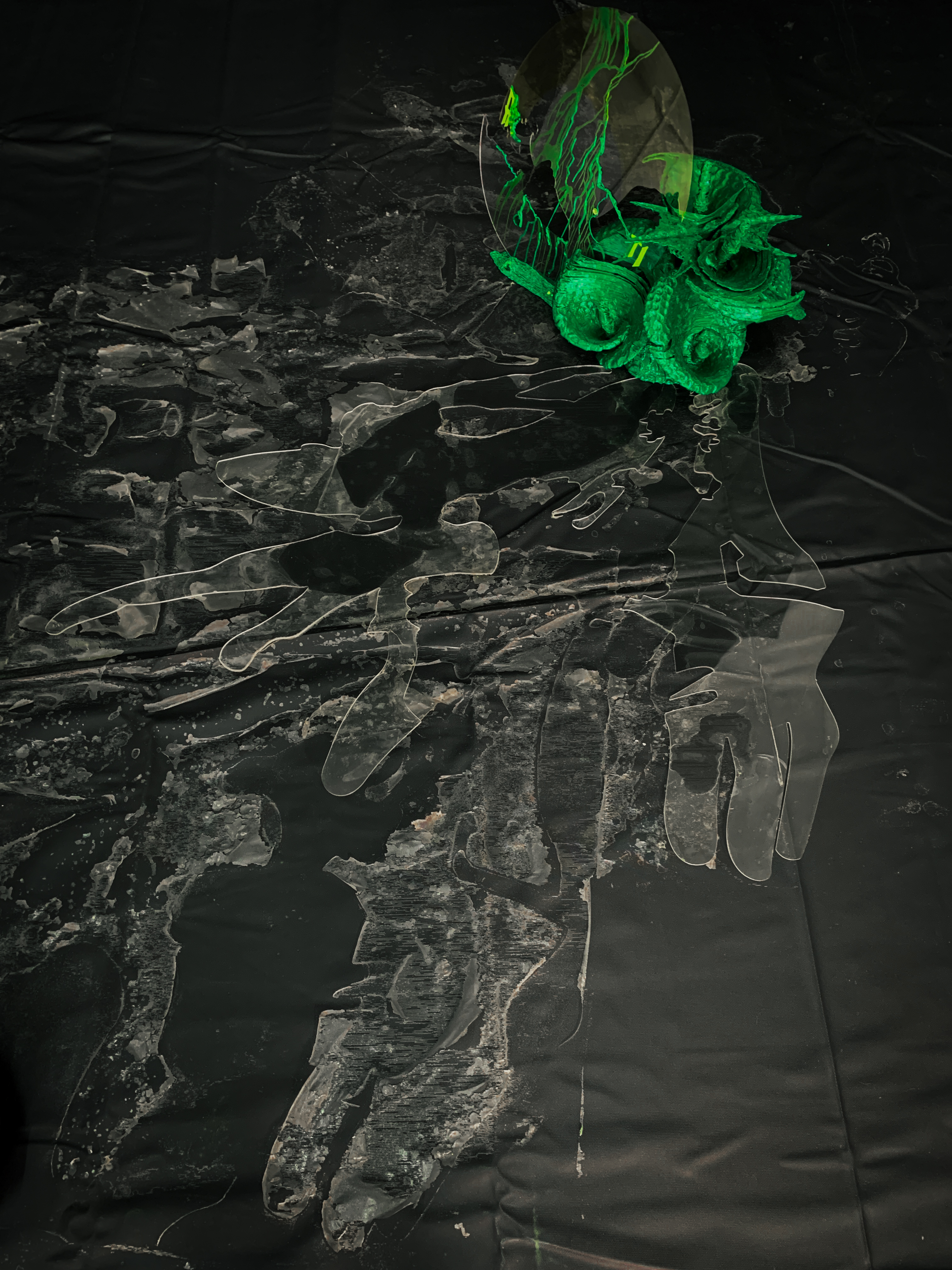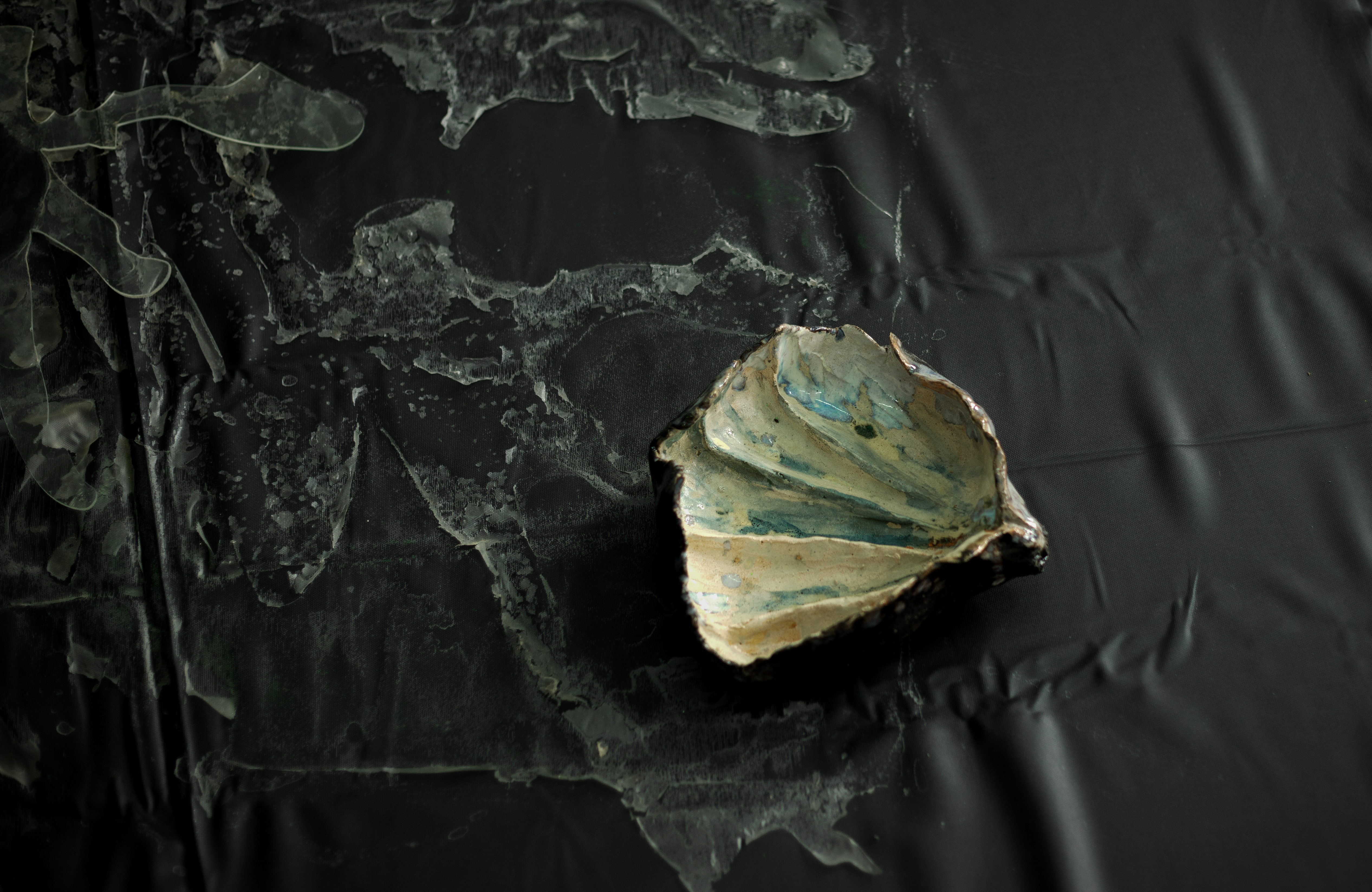Un salar verde salitre sueña con
instalación en el estudio 35.000 jóvenes
Madrid (SP) 2022
IX Premio a la Producción Artística de la Fundación Banco Santander y Open Studio
Texto de sala
Cristina Mejías
Un salar verde salitre sueña con*
nueve carpas y un millón de escamas.
Un millón de escamas dejan un hueco hueco,
y veintitrés gestos de un mismo centelleo.
Te preguntas ¿cómo continuar?
y continuaremos a little further yet.
Signo cóncavo o convexo,
Ufano ligero guijarro que cambia el curso de un río,
Salta el agua y el reflejo repite su movimiento, como un eco.
Brilla pantanoso y dorado,
un ruido blanco de dieciocho miembros.
En este lugar encuentras lo que ha quedado en la orilla después de una corriente de tiempos, donde una garganta traga o escupe un amuleto. Una superficie que funciona como prisma de un espectro, dejando visible una imagen o el material desnudo, sin reflejo. Establecer conexiones entre la imagen plana y el objeto lleno es sobre todo eléctrico, algo así como meter la mano en un espejo.
*Salgado, María. Salitre. 2019.
[eng]
Exhibition text
Cristina Mejías
Un salar verde salitre sueña con*
nine carps and a million scales.
A million scales leave a hollow hole,
and twenty-three gestures of the same twinkle.
You ask yourself: how to continue?
and we will continue a little further yet.
Concave or convex sign,
Conceited light pebble that changes the course of a river,
The water jumps and the reflection repeats its movement, like an echo.
It shines swampy and golden,
a white noise of eighteen limbs.
In this place you find what is left on the shore after a current of times, where a throat swallows or spits out an amulet. A surface that works as a prism of a specter, making visible an image or the naked material, without reflection. Establishing connections between the flat image and the full object is above all electric, something like sticking the hand in a mirror.
*Salgado, María. Salitre, 2019





STATEMENT
Irati Inoriza
Un cuerpo de esculturas se presentan sobre una lona negra que funciona de soporte y proyección. Se articula un dispositivo desde el residuo, lo que queda de la experiencia vivida, aflora. Es el resultado de la cohabitación en el estudio, con otros artistas y materiales.
Esta propuesta nace desde la convivencia con el agua, entendido como material y signo, me he centrado en sus características plásticas como son: lo fluido, el reflejo y el flujo, y lo que queda de la experiencia con este elemento. “Salitre es lo que queda” dice María Salgado en su poemario Salitre.
Atenta al gesto que se produce entre el agua y el cuerpo, me interesa la dialéctica con este medio durante la historia del arte y su presencia en la actualidad para entrever lo transformable, lo que cambia y no perdura.
Presento una instalación donde las formas nacen desde la repetición, y en ese proceso de repetición van evolucionando como un cuerpo que se transforma, atravesando la idea de transitoriedad como lugar habitable y pensando en otras naturalezas posibles.
El circuito y la orilla, lo orgánico, lo escultórico y lo performativo están presentes.
Irati Inoriza
Un cuerpo de esculturas se presentan sobre una lona negra que funciona de soporte y proyección. Se articula un dispositivo desde el residuo, lo que queda de la experiencia vivida, aflora. Es el resultado de la cohabitación en el estudio, con otros artistas y materiales.
Esta propuesta nace desde la convivencia con el agua, entendido como material y signo, me he centrado en sus características plásticas como son: lo fluido, el reflejo y el flujo, y lo que queda de la experiencia con este elemento. “Salitre es lo que queda” dice María Salgado en su poemario Salitre.
Atenta al gesto que se produce entre el agua y el cuerpo, me interesa la dialéctica con este medio durante la historia del arte y su presencia en la actualidad para entrever lo transformable, lo que cambia y no perdura.
Presento una instalación donde las formas nacen desde la repetición, y en ese proceso de repetición van evolucionando como un cuerpo que se transforma, atravesando la idea de transitoriedad como lugar habitable y pensando en otras naturalezas posibles.
El circuito y la orilla, lo orgánico, lo escultórico y lo performativo están presentes.
[eng]
A body of sculptures is presented on a black tarpaulin that works as a support and projection. A device is articulated from the residue, what remains of the lived experience comes to the surface. It is the result of cohabitation in the studio, with other artists and materials.
This proposal is born from the coexistence with water, understood as material and sign, I have focused on its plastic characteristics such as: the fluid, the reflection and the flow, and what remains of the experience with this element. "Salitre es lo que queda" [saltpetre is what remains] says María Salgado in her book Salitre.
Being attentive to the gesture produced between water and body, I am interested in the dialectics with this medium during the history of art and its presence today to glimpse what is transformable, what changes and does not last.
I present an installation where the forms are born from repetition, and in this process of repetition they evolve as a body that transforms, crossing the idea of transience as a an habitable place and thinking about other possible natures.
The circuit and the shore, the organic, the sculptural and the performative are present.



























Photos by Mala Sombra & Vero Martín Zelich
Diseño de cartel con Leire Lacunza